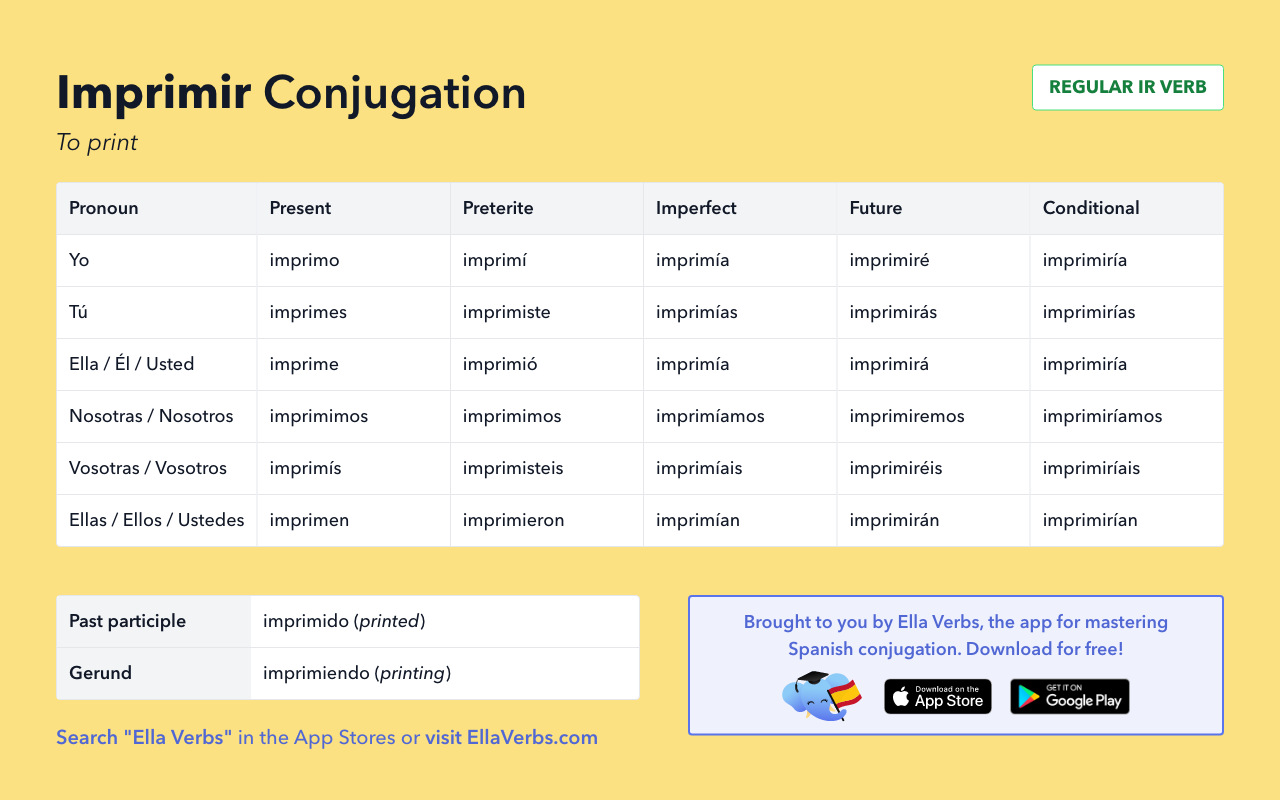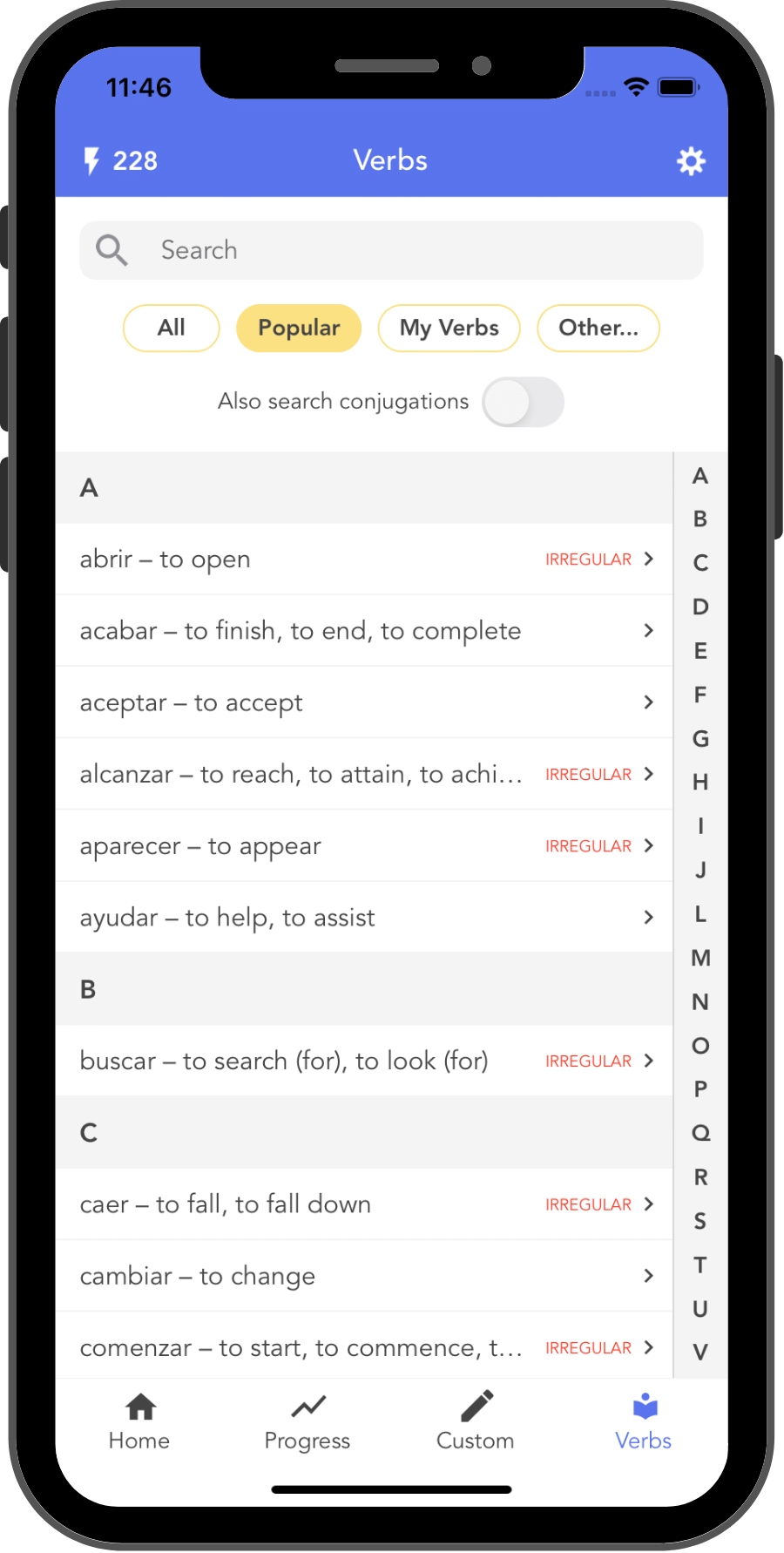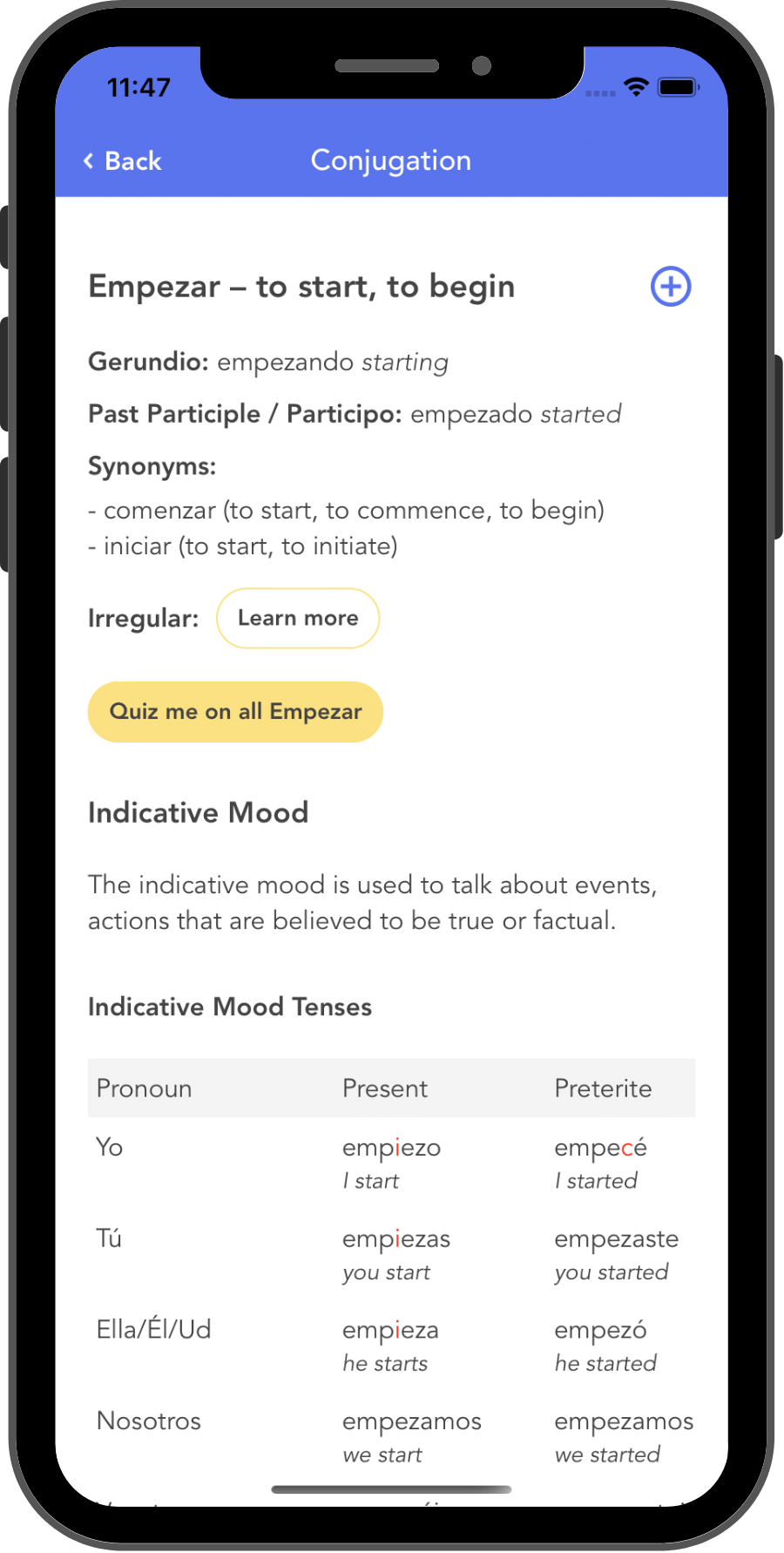 Ella Verbs
Ella VerbsHow to conjugate Imprimir in Spanish
To print Regular IR Verb
Table of Contents
- Introduction
- Indicative tenses of Imprimir
- Imprimir in the Indicative Present
- Imprimir in the Indicative Preterite
- Imprimir in the Indicative Imperfect
- Imprimir in the Indicative Present Continuous
- Imprimir in the Indicative Informal Future
- Imprimir in the Indicative Future
- Imprimir in the Indicative Conditional
- Imprimir in the Indicative Present Perfect
- Imprimir in the Indicative Past Perfect
- Imprimir in the Indicative Future Perfect
- Imprimir in the Indicative Conditional Perfect
- Subjunctive tenses of Imprimir
- Imperative tenses of Imprimir
- Downloadable cheat sheet (PDF)
- Practice Imprimir conjugations (free mobile app)
Introduction
Imprimir is the Spanish verb for "to print". It is a regular IR verb. Read on below to see how it is conjugated in the 18 major Spanish tenses!
| Item | Spanish | English |
|---|---|---|
| Infinitive | imprimir | to print |
| Past participle | imprimido | printed |
| Gerund | imprimiendo | printing |
Indicative Tenses of Imprimir
Imprimir in the Indicative Present
The Indicative Present of imprimir is used to talk about situations, events or thoughts that are happening now or in the near future. It is also used to talk about facts and truths. For example, "imprimo", meaning "I print".
In Spanish, the Indicative Present is known as "El Presente".
| Pronoun | Spanish | English |
|---|---|---|
| Yo | imprimo | I print |
| Tú | imprimes | you print |
| Ella / Él / Usted | imprime | s/he prints, you (formal) print |
| Nosotras / Nosotros | imprimimos | we print |
| Vosotras / Vosotros | imprimís | you (plural) print |
| Ellas / Ellos / Ustedes | imprimen | they print |
Back to top
Imprimir in the Indicative Preterite
The Indicative Preterite of imprimir is used to talk about actions completed in the past, at a specific point in time. For example, "imprimí", meaning "I printed".
In Spanish, the Indicative Preterite is known as "El Pretérito Indefinido".
| Pronoun | Spanish | English |
|---|---|---|
| Yo | imprimí | I printed |
| Tú | imprimiste | you printed |
| Ella / Él / Usted | imprimió | s/he printed, you (formal) printed |
| Nosotras / Nosotros | imprimimos | we printed |
| Vosotras / Vosotros | imprimisteis | you (plural) printed |
| Ellas / Ellos / Ustedes | imprimieron | they printed |
Back to top
Imprimir in the Indicative Imperfect
The Indicative Imperfect of imprimir is used to describe regular and repeated actions that happened in the past and descriptions of things you used to do. For example, "imprimía", meaning "I used to print".
In Spanish, the Indicative Imperfect is known as "El Pretérito Imperfecto".
| Pronoun | Spanish | English |
|---|---|---|
| Yo | imprimía | I used to print |
| Tú | imprimías | you used to print |
| Ella / Él / Usted | imprimía | s/he used to print, you (formal) used to print |
| Nosotras / Nosotros | imprimíamos | we used to print |
| Vosotras / Vosotros | imprimíais | you (plural) used to print |
| Ellas / Ellos / Ustedes | imprimían | they used to print |
Back to top
Imprimir in the Indicative Present Continuous
The Indicative Present Continuous of imprimir is used to talk about something that is happening continuously or right now. For example, "estoy imprimiendo", meaning "I am printing".
In Spanish, the Indicative Present Continuous is known as "El Presente Progresivo".
| Pronoun | Spanish | English |
|---|---|---|
| Yo | estoy imprimiendo | I am printing |
| Tú | estás imprimiendo | you are printing |
| Ella / Él / Usted | está imprimiendo | s/he is printing, you (formal) are printing |
| Nosotras / Nosotros | estamos imprimiendo | we are printing |
| Vosotras / Vosotros | estáis imprimiendo | you (plural) are printing |
| Ellas / Ellos / Ustedes | están imprimiendo | they are printing |
Back to top
Imprimir in the Indicative Informal Future
The Indicative Informal Future of imprimir is used to talk about something that will happen in the future, especially in the near future. For example, "voy a imprimir", meaning "I am going to print".
In Spanish, the Indicative Informal Future is known as "El Futuro Próximo".
| Pronoun | Spanish | English |
|---|---|---|
| Yo | voy a imprimir | I am going to print |
| Tú | vas a imprimir | you are going to print |
| Ella / Él / Usted | va a imprimir | s/he is going to print, you (formal) are going to print |
| Nosotras / Nosotros | vamos a imprimir | we are going to print |
| Vosotras / Vosotros | vais a imprimir | you (plural) are going to print |
| Ellas / Ellos / Ustedes | van a imprimir | they are going to print |
Back to top
Imprimir in the Indicative Future
The Indicative Future of imprimir is used to talk about something that will happen in the future. For example, "imprimiré", meaning "I will print".
In Spanish, the Indicative Future is known as "El Futuro Simple".
| Pronoun | Spanish | English |
|---|---|---|
| Yo | imprimiré | I will print |
| Tú | imprimirás | you will print |
| Ella / Él / Usted | imprimirá | s/he will print, you (formal) will print |
| Nosotras / Nosotros | imprimiremos | we will print |
| Vosotras / Vosotros | imprimiréis | you (plural) will print |
| Ellas / Ellos / Ustedes | imprimirán | they will print |
Back to top
Imprimir in the Indicative Conditional
The Indicative Conditional of imprimir is used to talk about something that may happen in the future, hypothesis and probabilities. For example, "imprimiría", meaning "I would print".
In Spanish, the Indicative Conditional is known as "El Condicional Simple".
| Pronoun | Spanish | English |
|---|---|---|
| Yo | imprimiría | I would print |
| Tú | imprimirías | you would print |
| Ella / Él / Usted | imprimiría | s/he would print, you (formal) would print |
| Nosotras / Nosotros | imprimiríamos | we would print |
| Vosotras / Vosotros | imprimiríais | you (plural) would print |
| Ellas / Ellos / Ustedes | imprimirían | they would print |
Back to top
Imprimir in the Indicative Present Perfect
The Indicative Present Perfect of imprimir is used to describe actions that started recently (in the past) and are still happening now or things that have been done recently. For example, "he imprimido", meaning "I have printed".
In Spanish, the Indicative Present Perfect is known as "El Pretérito Perfecto".
| Pronoun | Spanish | English |
|---|---|---|
| Yo | he imprimido | I have printed |
| Tú | has imprimido | you have printed |
| Ella / Él / Usted | ha imprimido | s/he has printed, you (formal) have printed |
| Nosotras / Nosotros | hemos imprimido | we have printed |
| Vosotras / Vosotros | habéis imprimido | you (plural) have printed |
| Ellas / Ellos / Ustedes | han imprimido | they have printed |
Back to top
Imprimir in the Indicative Past Perfect
The Indicative Past Perfect of imprimir is used to talk about actions that happened before another action in the past. For example, "había imprimido", meaning "I had printed".
In Spanish, the Indicative Past Perfect is known as "El Pretérito Pluscuamperfecto".
| Pronoun | Spanish | English |
|---|---|---|
| Yo | había imprimido | I had printed |
| Tú | habías imprimido | you had printed |
| Ella / Él / Usted | había imprimido | s/he had printed, you (formal) had printed |
| Nosotras / Nosotros | habíamos imprimido | we had printed |
| Vosotras / Vosotros | habíais imprimido | you (plural) had printed |
| Ellas / Ellos / Ustedes | habían imprimido | they had printed |
Back to top
Imprimir in the Indicative Future Perfect
The Indicative Future Perfect of imprimir is used to talk about something that will have happened in the future after something else has already happened. For example, "habré imprimido", meaning "I will have printed".
In Spanish, the Indicative Future Perfect is known as "El Futuro Perfecto".
| Pronoun | Spanish | English |
|---|---|---|
| Yo | habré imprimido | I will have printed |
| Tú | habrás imprimido | you will have printed |
| Ella / Él / Usted | habrá imprimido | s/he will have printed, you (formal) will have printed |
| Nosotras / Nosotros | habremos imprimido | we will have printed |
| Vosotras / Vosotros | habréis imprimido | you (plural) will have printed |
| Ellas / Ellos / Ustedes | habrán imprimido | they will have printed |
Back to top
Imprimir in the Indicative Conditional Perfect
The Indicative Conditional Perfect of imprimir is used to talk about something that would have happened in the past but didn’t due to another action. For example, "habría imprimido", meaning "I would have printed".
In Spanish, the Indicative Conditional Perfect is known as "El Condicional Perfecto".
| Pronoun | Spanish | English |
|---|---|---|
| Yo | habría imprimido | I would have printed |
| Tú | habrías imprimido | you would have printed |
| Ella / Él / Usted | habría imprimido | s/he would have printed, you (formal) would have printed |
| Nosotras / Nosotros | habríamos imprimido | we would have printed |
| Vosotras / Vosotros | habríais imprimido | you (plural) would have printed |
| Ellas / Ellos / Ustedes | habrían imprimido | they would have printed |
Back to top
Subjunctive Tenses of Imprimir
Imprimir in the Subjunctive Present
The Subjunctive Present is used to talk about situations of uncertainty, or emotions such as wishes, desires and hopes. It differs from the indicative mood due to the uncertainty of the events which are being spoken about. For example, "imprima", meaning "I print".
In Spanish, the Subjunctive Present is known as "El Presente de Subjuntivo".
| Pronoun | Spanish | English |
|---|---|---|
| Yo | imprima | I print |
| Tú | imprimas | you print |
| Ella / Él / Usted | imprima | s/he prints, you (formal) print |
| Nosotras / Nosotros | imprimamos | we print |
| Vosotras / Vosotros | imprimáis | you (plural) print |
| Ellas / Ellos / Ustedes | impriman | they print |
Back to top
Imprimir in the Subjunctive Imperfect
The Subjunctive Imperfect is used to speak about unlikely or uncertain events in the past or to cast an opinion (emotional) about something that happened in the past. For example, "imprimiera", meaning "I printed".
In Spanish, the Subjunctive Imperfect is known as "El Imperfecto Subjuntivo".
| Pronoun | Spanish | English |
|---|---|---|
| Yo | imprimiera | I printed |
| Tú | imprimieras | you printed |
| Ella / Él / Usted | imprimiera | s/he printed, you (formal) printed |
| Nosotras / Nosotros | imprimiéramos | we printed |
| Vosotras / Vosotros | imprimierais | you (plural) printed |
| Ellas / Ellos / Ustedes | imprimieran | they printed |
Back to top
Imprimir in the Subjunctive Future
The Subjunctive Future is used to speak about hypothetical situations, and actions/events that may happen in the future. For example, "imprimiere", meaning "I will print".
In Spanish, the Subjunctive Future is known as "El Futuro de Subjuntivo".
| Pronoun | Spanish | English |
|---|---|---|
| Yo | imprimiere | I will print |
| Tú | imprimieres | you will print |
| Ella / Él / Usted | imprimiere | s/he will print, you (formal) will print |
| Nosotras / Nosotros | imprimiéremos | we will print |
| Vosotras / Vosotros | imprimiereis | you (plural) will print |
| Ellas / Ellos / Ustedes | imprimieren | they will print |
Back to top
Imprimir in the Subjunctive Present Perfect
The Subjunctive Present Perfect is used to describe past actions or events that are still connected to the present day and to speak about an action that will have happened by a certain time in the future. For example, "haya imprimido", meaning "I have printed".
In Spanish, the Subjunctive Present Perfect is known as "El Pretérito Perfecto de Subjuntivo".
| Pronoun | Spanish | English |
|---|---|---|
| Yo | haya imprimido | I have printed |
| Tú | hayas imprimido | you have printed |
| Ella / Él / Usted | haya imprimido | s/he has printed, you (formal) have printed |
| Nosotras / Nosotros | hayamos imprimido | we have printed |
| Vosotras / Vosotros | hayáis imprimido | you (plural) have printed |
| Ellas / Ellos / Ustedes | hayan imprimido | they have printed |
Back to top
Imprimir in the Subjunctive Past Perfect
The Subjunctive Past Perfect is used to speak about hypothetical situations, and actions/events that occurred before other actions/events in the past. For example, "hubiera imprimido", meaning "I had printed".
In Spanish, the Subjunctive Past Perfect is known as "El Pretérito Pluscuamperfecto de Subjuntivo".
| Pronoun | Spanish | English |
|---|---|---|
| Yo | hubiera imprimido | I had printed |
| Tú | hubieras imprimido | you had printed |
| Ella / Él / Usted | hubiera imprimido | s/he had printed, you (formal) had printed |
| Nosotras / Nosotros | hubiéramos imprimido | we had printed |
| Vosotras / Vosotros | hubierais imprimido | you (plural) had printed |
| Ellas / Ellos / Ustedes | hubieran imprimido | they had printed |
Back to top
Imprimir in the Subjunctive Future Perfect
The Subjunctive Future Perfect is used to speak about something that will have happened if a hypothetical situations occurs in the future. For example, "hubiere imprimido", meaning "I will have printed".
In Spanish, the Subjunctive Future Perfect is known as "El Futuro Perfecto de Subjuntivo".
| Pronoun | Spanish | English |
|---|---|---|
| Yo | hubiere imprimido | I will have printed |
| Tú | hubieres imprimido | you will have printed |
| Ella / Él / Usted | hubiere imprimido | s/he will have printed, you (formal) will have printed |
| Nosotras / Nosotros | hubiéremos imprimido | we will have printed |
| Vosotras / Vosotros | hubiereis imprimido | you (plural) will have printed |
| Ellas / Ellos / Ustedes | hubieren imprimido | they will have printed |
Back to top
Imperative Tenses of Imprimir
Imprimir in the Imperative Affirmative
The Imperative Affirmative is used to give orders and commands, to tell someone to do something. For example, "imprima", meaning "(to you formal) print!".
In Spanish, the Imperative Affirmative is known as "El Imperativo Afirmativo".
| Pronoun | Spanish | English |
|---|---|---|
| Yo | - | - |
| Tú | imprime | (to you) print! |
| Ella / Él / Usted | imprima | (to you formal) print! |
| Nosotras / Nosotros | imprimamos | let's print! |
| Vosotras / Vosotros | imprimid | (to you plural) print! |
| Ellas / Ellos / Ustedes | impriman | (to you plural formal) print! |
Back to top
Imprimir in the Imperative Negative
The Imperative Negative is used to give orders and commands, telling someone not to do something. For example, "no imprima", meaning "(to you formal) don't print!".
In Spanish, the Imperative Negative is known as "El Imperativo Negativo".
| Pronoun | Spanish | English |
|---|---|---|
| Yo | - | - |
| Tú | no imprimas | (to you) don't print! |
| Ella / Él / Usted | no imprima | (to you formal) don't print! |
| Nosotras / Nosotros | no imprimamos | let's not print! |
| Vosotras / Vosotros | no imprimáis | (to you plural) don't print! |
| Ellas / Ellos / Ustedes | no impriman | (to you plural formal) don't print! |
Back to top
Downloadable cheat sheets
Download and print a cheat sheet of Imprimir Spanish conjugation tables in image or PDF format:

Back to top
Practice Imprimir conjugations (free mobile & web app)
Get full conjugation tables for Imprimir and 2,300+ other verbs on-the-go with Ella Verbs for iOS, Android, and web.
We also guide you through learning all Spanish tenses and test your knowledge with conjugation quizzes. Download it for free!


Back to top
About Ella Verbs
👋 Hola! We built Ella Verbs to help people (and ourselves!) master one of the hardest parts of Spanish – verb conjugation. It guides you through learning all tenses in an easy-to-follow way, giving you levels of bite-sized lessons and fun quizzes. Here is a 6 minute overview of all of the app's features:
It has changed a lot over the 6+ years we have been working on it, but the goal remains the same – to help you master Spanish conjugation! You can download and try it for free, and, if you do, please send any and all feedback our way!
- Jane & Brian
Back to top
Want to explore other verb conjugations?
Why not check out Inclinar – to incline, to tip (over) or see the complete list of verbs here.
Back to top
Imprimir: to print
Remove the mystery behind Spanish conjugation with Ella Verbs
- Learn how to conjugate (not just memorize)
- Discover & focus on your weaknesses
- Interactive quizzes that you actually learn from
- Free to try, and free forever for those who cannot afford it.
